Bestsellers
-

Raspberry Pi Foundation Raspberry Pi SSD Kit for Raspberry Pi 5 (256 GB)
The Raspberry Pi SSD Kit bundles a Raspberry Pi M.2 HAT+ with a Raspberry Pi NVMe SSD. It unlocks outstanding performance for I/O intensive applications on Raspberry Pi 5, including super-fast startup when booting from SSD. The Raspberry Pi SSD Kit is also available with 512 GB capacity. Features 40k IOPS (4 kB random reads) 70k IOPS (4 kB random writes) Conforms to the Raspberry Pi HAT+ specification Included 256 GB NVMe SSD M.2 HAT+ for Raspberry Pi 5 16 mm GPIO stacking header Mounting hardware kit (spacers, screws) Downloads Datasheet
€ 44,95€ 39,95
Members identical
-

Arduino Official Arduino USB-C Cable (2-in-1)
Now you can connect your Arduino boards with the official Arduino USB cable. Through a USB-C to USB-C with a USB-A adapter connection, this data USB cable can easily connect your Arduino boards with your chosen programming device. The Arduino USB cable has a nylon braided jacket in the typical Arduino colors white and teal. The connectors have an aluminum shell that protects your cable from harm at the same time as looking cool. Length: 100 cm Aluminium shell with logo Nylon braided jacket white and teal
€ 12,95
Members € 11,66
-

Elektor Publishing How Humanity Turned Electricity into Electronics
From Rubbing Amber to Swiping Glass "The story of electricity, told one connection at a time."Why does rubbing amber attract dust? How did we go from that curious effect to a world where screens respond to a single touch? And how did we get from mysterious sparks to tiny chips packed with billions of transistors? For centuries, electricity puzzled and fascinated those who encountered its curious effects—long before it even had a name. From the earliest observations of static charge to the complex electronics that shape our lives today, this book traces the gradual, and often surprising, story of how humanity came to understand and harness this powerful force. This book offers an engaging and accessible account of the people, ideas, and inventions that transformed electricity from a scientific curiosity into the foundation of our digital age. Along the way, you’ll meet a host of inquisitive minds—some famous, others less so—whose persistence and creativity helped unravel the mysteries of the natural world and gave rise to the technologies we now take for granted. Covering everything from Leyden jars and batteries to transistors, microcontrollers and the internet, this book presents a clear and enjoyable overview of electronics and its relatively short, yet rich, history. Whether you have a technical background or simply a curiosity about how things work, From Rubbing Amber to Swiping Glass offers a thoughtful look at how far we’ve come—and a gentle nudge to wonder what might come next.
€ 39,95
Members € 35,96
-
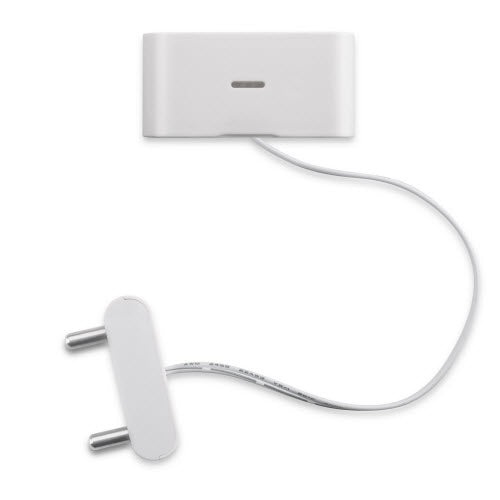
Dragino Dragino LWL01 LoRaWAN Water Leak Sensor (EU868)
LWL01 is powered by a CR2032 coin battery, in a good LoRaWAN Network Coverage case, it can transmit as many as 12,000 uplink packets (based on SF 7, 14 dB). In poor LoRaWAN network coverage, it can transmit ~ 1,300 uplink packets (based on SF 10, 18.5 B). The design goal for one battery is up to 2 years. User can easily change the CR2032 battery for reuse. The LWL01 will send periodically data every day as well as for water leak event. It also counts the water leak event times and also calculates last water leak duration. Each LWL01 is pre-load with a set of unique keys for LoRaWAN registration, register these keys to local LoRaWAN server and it will auto connect after power on. Features LoRaWAN v1.0.3 Class A SX1262 LoRa Core Water Leak detect CR2032 battery powered AT Commands to change parameters Uplink on periodically and water leak event Downlink to change configure Applications Wireless Alarm and Security Systems Home and Building Automation Industrial Monitoring and Control
€ 19,95
Members € 17,96
-
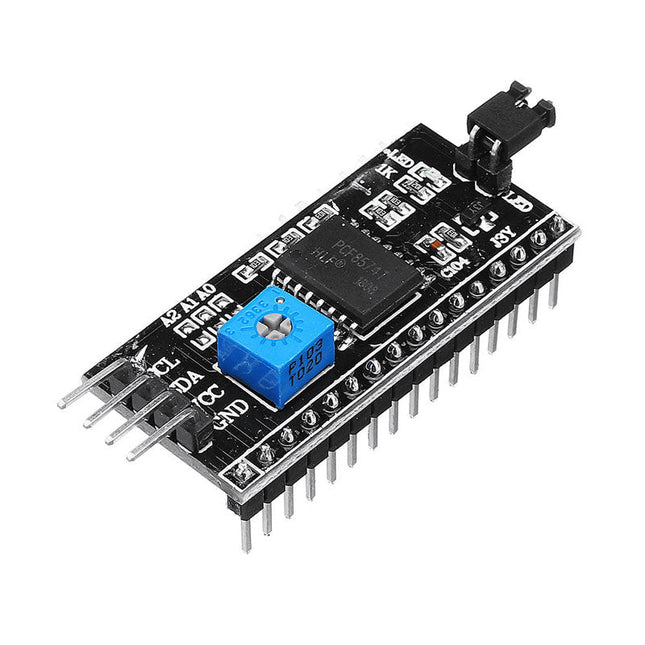
Kuongshun IIC/I²C Serial Interface Adapter Module
This is another great IIC/I²C/TWI/SPI Serial Interface. As the pin resources of controller is limited, your project may be not able to use normal LCD shield after connected with a certain quantity of sensors or SD card. However, with this I²C interface module, you will be able to realize data display via only 2 wires. If you already has I²C devices in your project, this LCD module actually cost no more resources at all. It is fantastic for based project. I²C Address: 0X20~0X27 (the original address is 0X20,you can change it yourself) The backlight and contrast is adjusted by potentiometer Comes with 2 IIC interface, which can be connected by Dupont Line or IIC dedicated cable I²C Address: 0x27 (I²C Address: 0X20~0X27 (the original address is 0X27,you can change it yourself) Specifications Compatible for 1602 LCD Supply voltage: 5 V Weight: 5 g Size: 5.5 x 2.3 x 1.4 cm
€ 4,95
Members € 4,46
-
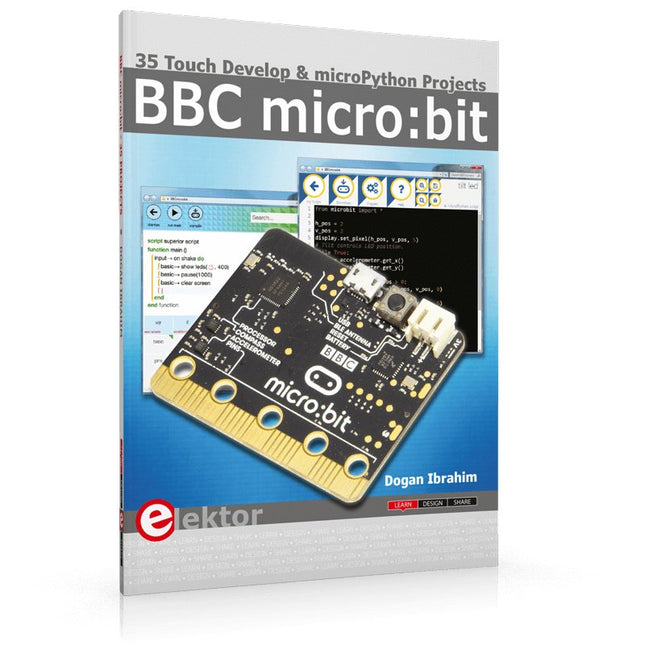
Elektor Publishing BBC micro:bit (Book)
35 Touch Develop & MicroPython Projects The BBC micro:bit is a credit sized computer based on a highly popular and high performance ARM processor. The device is designed by a group of 29 partners for use in computer education in the UK and will be given free of charge to every secondary school student in the UK. The device is based on the Cortex-M0 processor and it measures 4 x 5 cm. It includes several important sensors and modules such as an accelerometer, magnetometer, 25 LEDs, 2 programmable push-button switches, Bluetooth connectivity, micro USB socket, 5 ring type connectors, and a 23-pin edge connector. The device can be powered from its micro USB port by connecting it to a PC, or two external AAA type batteries can be used. This book is about the use of the BBC micro:bit computer in practical projects. The BBC micro:bit computer can be programmed using several different programming languages, such as Microsoft Block Editor, Microsoft Touch Develop, MicroPython, and JavaScript. The book makes a brief introduction to the Touch Develop programming language and the MicroPython programming language. It then gives 35 example working and tested projects using these language. Readers who learn to program in Touch Develop and MicroPython should find it very easy to program using the Block Editor or any other languages. The following are given for each project: Title of the project Description of the project Aim of the project Touch Develop and MicroPython program listings Complete program listings are given for each project. In addition, working principles of the projects are described briefly in each section. Readers are encouraged to go through the projects in the order given in the book.
€ 29,95
Members € 26,96
-
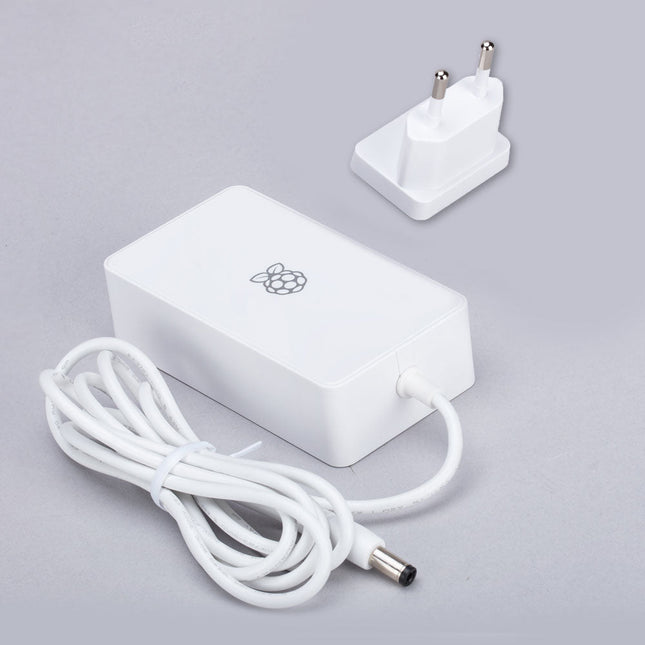
Raspberry Pi Foundation Power Supply for Raspberry Pi Build HAT (48 W)
This 48 W (8 VDC, 6 A) power supply is designed for the use with the Raspberry Pi Build HAT. Input: 110-240 VAC Output: 8 VDC, 6 A Cable: 1.5 m, 16 awg
€ 17,95
Members identical
-

Cambridge University Press Learning the Art of Electronics (2nd Edition)
A Hands-On Lab Course This introduction to circuit design is unusual in several respects. First, it offers not just explanations, but a full course. Each of the twenty-five sessions begins with a discussion of a particular sort of circuit followed by the chance to try it out and see how it actually behaves. Accordingly, students understand the circuit's operation in a way that is deeper and much more satisfying than the manipulation of formulas. Second, it describes circuits that more traditional engineering introductions would postpone: on the third day, we build a radio receiver; on the fifth day, we build an operational amplifier from an array of transistors. The digital half of the course centers on applying microcontrollers, but gives exposure to Verilog, a powerful Hardware Description Language. Third, it proceeds at a rapid pace but requires no prior knowledge of electronics. Students gain intuitive understanding through immersion in good circuit design. The course is intensive, teaching electronics in day-at-a-time practical doses so that students can learn in a hands-on way. The integration of discussion of design with a chance to try the circuits means students learn quickly. The course has been tried and tested, and proven successful through twenty-five years of teaching. The book is practical: it avoids mathematics and mathematical arguments and even includes a complete list of parts needed in the laboratory exercises, including where and how to buy them. The much-anticipated new edition of 'Learning the Art of Electronics' is here! It defines a hands-on course, inviting the reader to try out the many circuits that it describes. Several new labs (on amplifiers and automatic gain control) have been added to the analog part of the book, which also sees an expanded treatment of meters. Many labs now have online supplements. The digital sections have been rebuilt. An FPGA replaces the less-capable programmable logic devices, and a powerful ARM microcontroller replaces the 8051 previously used. The new microcontroller allows for more complex programming (in C) and more sophisticated applications, including a lunar lander, a voice recorder, and a lullaby jukebox. A new section explores using an Integrated Development Environment to compile, download, and debug programs. Substantial new lab exercises, and their associated teaching material, have been added, including a project reflecting this edition's greater emphasis on programmable logic. Online resources including online chapters, teaching materials and video demonstrations can be found at: www.LearningTheArtOfElectronics.com Downloads Table of Contents
€ 94,95€ 69,95
Members identical
-
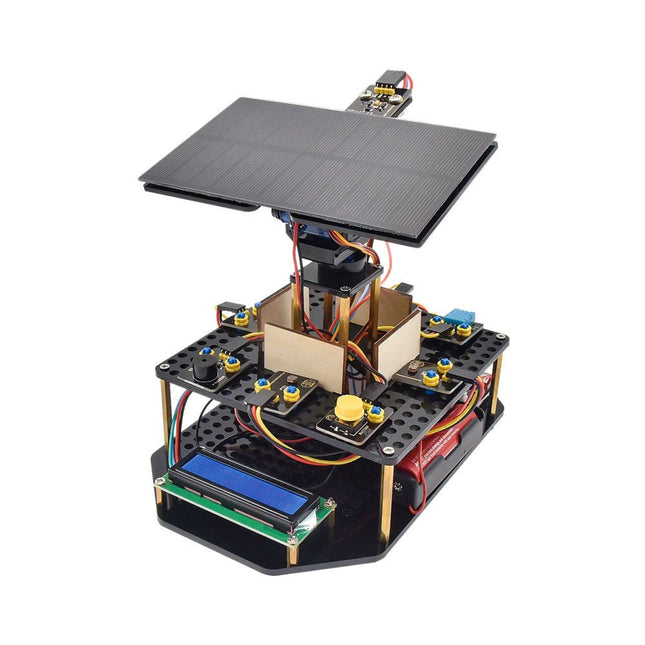
Keyestudio Keyestudio Solar Tracking DIY Kit for Arduino
The solar tracking kit is based on Arduino. It consists of 4 ambient light sensors, 2 DOF servos, a solar panel and so on, aiming at converting light energy into electronic energy and charging power devices. It also boasts a charging module, a temperature and humidity sensor, a BH1750 light sensor, a buzzer, an LCD1602 display, a push button module, an LED module and others, highly enriching the tutorial and making projects more interesting. This kit can not only help kids have a better learning about programming but obtain knowledge about electronics, machinery, controlling logic and computer science. Features Multiple functions: Track light automatically, read temperature, humidity and light intensity, button control, LCD1602 display and charge by solar energy. Easy to build: Insert into Lego jack to install and no need to fix with screws and nuts or solder circuit; also easy to dismantle. Novel style: Adopt acrylic boards and copper pillars; sensors or modules connected to acrylic boards via Lego jacks; LCD1602 modules and solar panels add technologies to it. High extension: Preserve I²C, UART, SPI ports and Lego jacks, and extend other sensors and modules. Basic programming: Program in C language with Arduino IDE. Specifications Working voltage 5 V Input voltage 3.7 V Max. output current 1.5 A Max. power dissipation 7.5 W Downloads Wiki
€ 74,95€ 59,95
Members identical
-
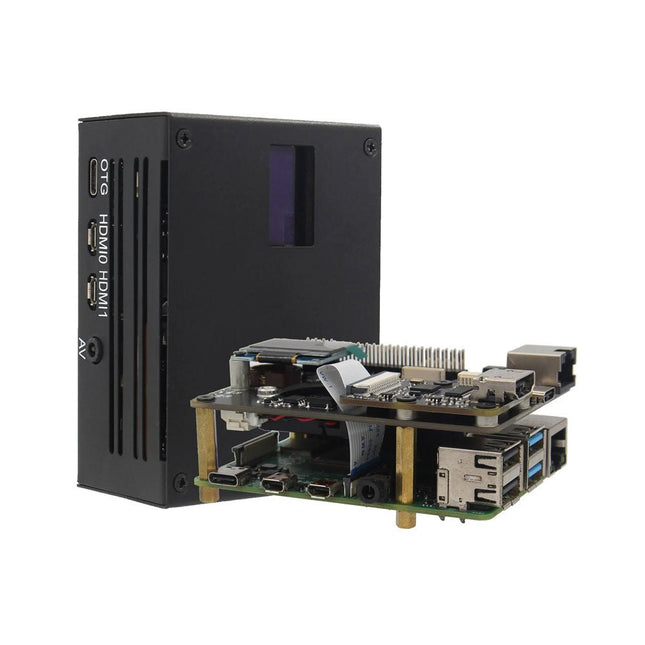
Geekworm Geekworm KVM-A3 Kit for Raspberry Pi 4 (+ FREE E-book)
EASTER SALE: Order the Geekworm KVM-A3 Kit now and receive the e-book Raspberry Pi Full Stack (worth €35) for FREE! KVM stands for Keyboard, Video, and Mouse and it is a powerful open-source software that enables remote access via Raspberry Pi. This KVM-A3 kit is designed based on the Raspberry Pi 4. With it, you can turn your computer on or off, restart it, configure the UEFI/BIOS, and even reinstall the operating system using a virtual CD-ROM or flash drive. You can either use your own remote keyboard and mouse, or let KVM simulate a keyboard, mouse, and monitor – presented through a web browser as if you were directly interacting with the remote system. It's true hardware-level access with no dependency on remote ports, protocols, or services! Features Designed especially for KVM (an open and affordable DIY IP-KVM based on Raspberry Pi) Compatible with Raspberry Pi 4 (not included) Fully compatible with PiKVM V3 OS Control a server or computer using a web browser HDMI Full HD capture based on the TC358743 chip OTG keyboard and mouse support; mass storage drive emulation Hardware Real-Time Clock (RTC) with CR1220 coin battery socket Equipped with a cooling fan to dissipate heat from the Raspberry Pi Features solid-state relays to protect Raspberry Pi GPIO pins from computer and ESD spikes ATX control via RJ45 connector: switch the machine on or off, reset it, and monitor HDD and power LED status remotely 10-pin SH1.0 connector reserved for future I²S HDMI audio support 4-pin header and spacers reserved for I²C OLED display Included KVM-A3 Metal Case for Raspberry Pi 4 X630 HDMI to CSI-2 Module (for video capture) X630-A3 Expansion Board (provides Ethernet, cooling, RTC, power input, etc.) X630-A5 Adapter Board (installed inside the PC case; connects the computer motherboard to the IO panel cable of the PC case) 0.96-inch OLED Display (128 x 64 pixels) Ethernet Cable (TIA/EIA-568.B standard; also serves as the ATX control signal cable) Downloads Wiki PiKVM OS
€ 119,95€ 84,95
Members identical
-

Raspberry Pi Foundation Raspberry Pi AI HAT+ (26 TOPS)
The Raspberry Pi AI HAT+ is an expansion board designed for the Raspberry Pi 5, featuring an integrated Hailo AI accelerator. This add-on offers a cost-effective, efficient, and accessible approach to incorporating high-performance AI capabilities, with applications spanning process control, security, home automation, and robotics. Available in models offering 13 or 26 tera-operations per second (TOPS), the AI HAT+ is based on the Hailo-8L and Hailo-8 neural network accelerators. The 13 TOPS model efficiently supports neural networks for tasks like object detection, semantic and instance segmentation, pose estimation, and more. This 26 TOPS variant accommodates larger networks, enables faster processing, and is optimized for running multiple networks simultaneously. The AI HAT+ connects via the Raspberry Pi 5’s PCIe Gen3 interface. When the Raspberry Pi 5 is running a current version of the Raspberry Pi OS, it automatically detects the onboard Hailo accelerator, making the neural processing unit (NPU) available for AI tasks. Additionally, the rpicam-apps camera applications included in Raspberry Pi OS seamlessly support the AI module, automatically using the NPU for compatible post-processing functions. Included Raspberry Pi AI HAT+ (26 TOPS) Mounting hardware kit (spacers, screws) 16 mm GPIO stacking header Downloads Datasheet
€ 129,95€ 109,95
Members identical
-

Generic Ultrasonic Radar Robot Kit
This Mini Radar Robot is an exciting, programmable DIY kit that combines creativity, technology, and hands-on learning. The kit is perfect for tech enthusiasts, makers, and students eager to explore robotics and programming with Arduino or ESP8266. Equipped with a 2.8" TFT screen, it offers real-time visual feedback by detecting objects with its ultrasonic sensors. Targets within 1 meter are shown as red dots, while objects up to 4.5 m are displayed in digital form on the screen. Specifications Main Control Unit ESP8266 microcontroller + expansion board Material Constructed from high-quality acrylic sheet, ensuring durability and a sleek, modern look Operating Voltage 5 V/2 A Operating Temperature −40 to 85°C Dimensions 145 x 95 x 90 mm Installation No soldering and programming required Included 1x Servo motor 1x Ultrasonic transducer module 1x Microcontroller board 1x 2.8-inch display module 1x USB power supply 1x USB cable Acrylic mechanical elements All necessary cables, screws, nuts, and spacers
€ 54,95€ 39,95
Members identical
-
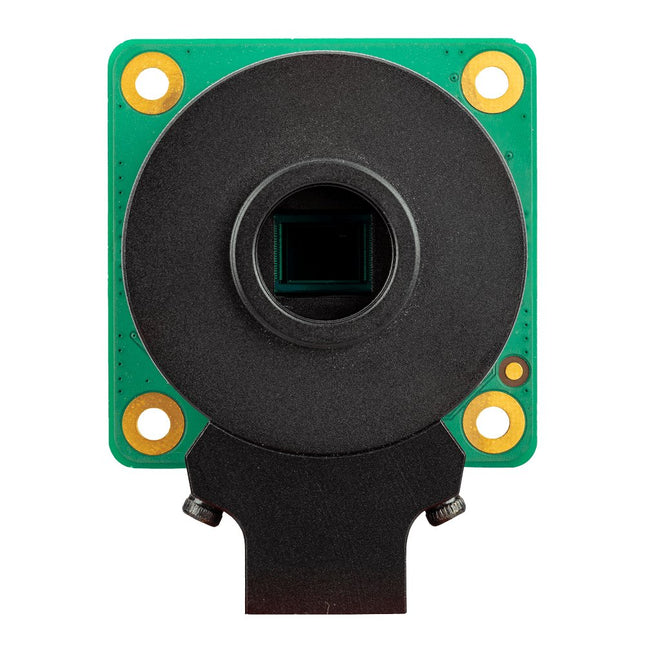
Raspberry Pi Foundation Raspberry Pi High Quality Camera Module (M12 Mount)
The Raspberry Pi High Quality Camera is an affordable high-quality camera from Raspberry Pi. It offers 12-megapixel resolution and a 7.9-mm diagonal sensor for impressive low-light performance. The M12 Mount variant is designed to work with most interchangeable M12 lenses, and the CS Mount variant is designed to work with interchangeable lenses in both CS and C mount form factors (C mount lenses require the use of the C-CS adapter included with this variant). Other lens form factors can be accommodated using third-party lens adapters. The High Quality Camera is well suited to industrial and consumer applications, including security cameras, which require the highest levels of visual fidelity and/ or integration with specialist optics. It is compatible with all models of Raspberry Pi from Model B onwards. Specifications Sensor Sony IMX477R stacked, back-illuminated sensor Resolution 12.3 megapixels Sensor size 7.9 mm sensor diagonal Pixel size 1.55 x 1.55 μm Output RAW12/10/8, COMP8 Back focus length of lens 2.6–11.8 mm (M12 Mount variant)12.5–22.4 mm (CS Mount variant) Lens sensor format 1/2.3” (7.9 mm) or larger IR cut filter Integrated Ribbon cable length 200 mm Tripod mount 1/4”-20 Included 1x Circuit board carrying a Sony IMX477 sensor 1x FPC cable for connection to a Raspberry Pi computer 1x Milled aluminium lens mount with integrated tripod mount 1x C to CS mount adapter 3x Lens locking rings Required M12 Mount Lens
€ 59,95
Members identical
-

KLOSE Mendocino Mendocino Motor AR O-8
The Mendocino Motor AR O-8 is a magnetically levitated, solar powered electric motor as a kit. Light Becomes Movement The solar-powered Mendocino motor seems to float in the air. At first glance, you can't see why the rotor is turning at all. This is the magic of the motor. The Lorentz force is a very small electrical force. In a classroom setting, it is detected by a current swing in the magnetic field. With the Mendocino motor, we have succeeded in developing a beautiful application that uses this weak force for propulsion. Due to its concealed base magnet, the motor will fascinate technically inclined observers. In bright sunlight, the motor can reach a speed of up to 1,000 rpm. More impressive, however, is that even the faint glow of an ample tea light (D = 6 cm with a flame height of about 2 cm) is sufficient to drive the motor. The motor is not yet an alternative source of energy, even though it looks tempting. Presumably, it will remain an attractive model until a resourceful mind disproves this assumption. Dimensions All solar cells 65 x 20 mm Mirror diameter: 25 mm Rotor weight: approx. 150 g Model length: 160 mm Model width: 85 mm Frame height: approx. 85 mm Frame material: black acrylic Tube made of highly polished aluminum Mirror color: silver The Mendocino motor’s easy-to-follow instruction manual includes more than 70 illustrations. It describes a safe and practical approach to construction but also gives you the freedom to try your solutions. Partly Pre-Assembled Kit A portion of the kit comes pre-assembled. Bonding the borosilicate glass pane to the acrylic surface requires specialized knowledge and aids. We do not want to impose this on the hobbyist. For instance, the base magnet is attached to the aluminum tube. As a hobbyist, you will need some know-how and appropriate tools: carpet knife, soldering iron and tin, hot glue, pliers, and a clamp or ferrule to fix the supplied assembly aid. A lot of fun is guaranteed!
€ 164,95€ 119,95
Members identical
-
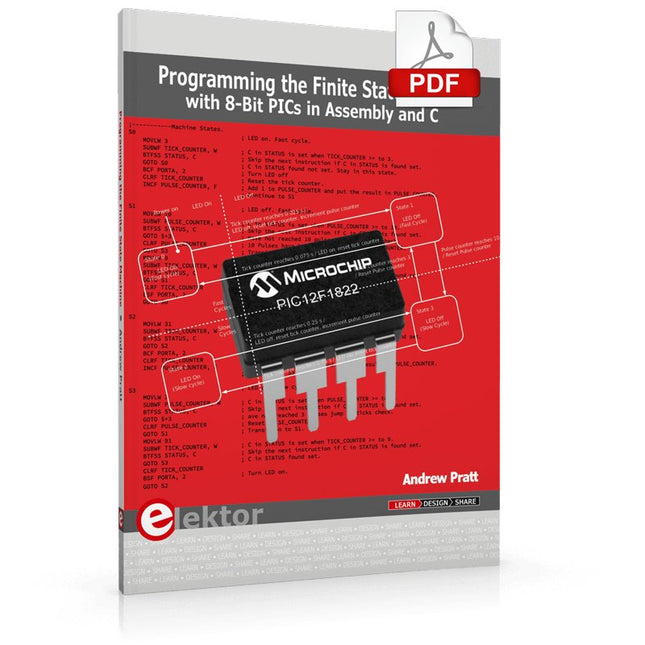
Elektor Digital Programming the Finite State Machine (E-book)
Programming the Finite State Machine with 8-Bit PICs in Assembly and C Andrew Pratt provides a detailed introduction to programming PIC microcontrollers, as well as a thorough overview of the Finite State Machine (FSM) approach to programming. Most of the book uses assembly programming, but do not be deterred. The FSM gives a structure to a program, making it easy to plan, write, and modify. The last two chapters introduce programming in C, so you can make a direct comparison between the two techniques. The book references the relevant parts of the Microchip datasheet as familiarity with it is the best way to discover detailed information. This book is aimed at Microsoft Windows and Linux users. To keep your costs to a minimum and to simplify the toolchain, specific applications are provided as a free download to enable you to use an FTDI serial lead as the programmer. The assembler used is the open-source "gpasm". All programming can be done in a text editor. There are detailed instructions on how to perform the necessary installations on Windows, Linux Debian, and derivatives such as Ubuntu and Fedora. For programming in C, Microchip's XC8 compiler is used from the command line. In addition to the programming applications, two serial read and serial write applications can be used for communicating with the PICs from a computer. A voltmeter project including practical instructions on building a circuit board from scratch is included. All theory is covered beforehand, including how to do integer arithmetic in assembly. Two PICs are covered: the PIC12F1822 and the PIC16F1823. Both can run at 32 MHz with an internal oscillator. You do not need to buy a factory-made development board and programmer. With relatively inexpensive parts including a serial lead, microcontroller, a few resistors, and LEDs, you can get started exploring embedded programming. Links Updated Programmer
€ 32,95
Members € 26,36
-
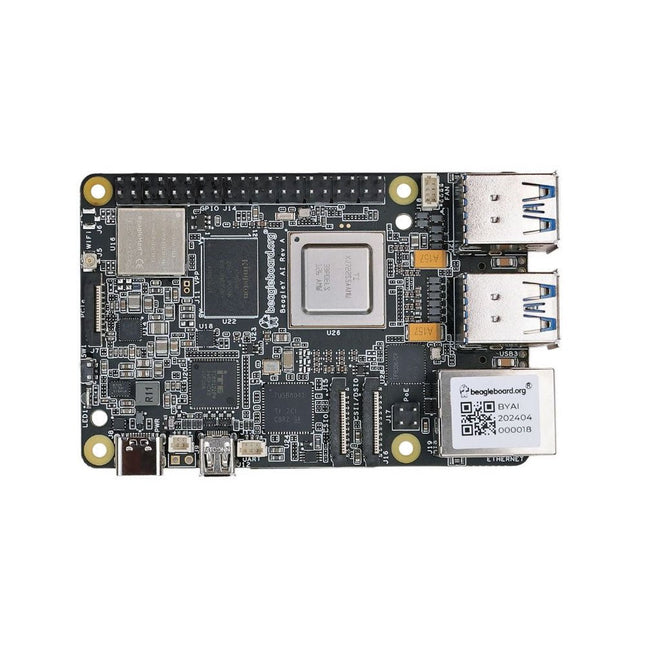
BeagleBoard BeagleY-AI SBC with GPU, DSP and AI Accelerators
BeagleY-AI is a low-cost, open-source, and powerful 64-bit quad-core single-board computer, equipped with a GPU, DSP, and vision/deep learning accelerators, designed for developers and makers. Users can take advantage of BeagleBoard.org's provided Debian Linux software images, which include a built-in development environment. This enables the seamless running of AI applications on a dedicated 4 TOPS co-processor, while simultaneously handling real-time I/O tasks with an 800 MHz microcontroller. BeagleY-AI is designed to meet the needs of both professional developers and educational environments. It is affordable, easy to use, and open-source, removing barriers to innovation. Developers can explore in-depth lessons or push practical applications to their limits without restriction. Specifications Processor TI AM67 with quad-core 64-bit Arm Cortex-A53, GPU, DSP, and vision/deep learning accelerators RAM 4 GB LPDDR4 Wi-Fi BeagleBoard BM3301 module based on TI CC3301 (802.11ax Wi-Fi) Bluetooth Bluetooth Low Energy 5.4 (BLE) USB • 4x USB-A 3.0 supporting simultaneous 5 Gbps operation• 1x USB-C 2.0 supports USB 2.0 device Ethernet Gigabit Ethernet, with PoE+ support (requires separate PoE+ HAT) Camera/Display 1x 4-lane MIPI camera/display transceivers, 1x 4-lane MIPI camera Display Output 1x HDMI display, 1x OLDI display Real-time Clock (RTC) Supports an external button battery for power failure time retention. It is only populated on EVT samples. Debug UART 1x 3-pin debug UART Power 5 V/5 A DC power via USB-C, with Power Delivery support Power Button On/Off included PCIe Interface PCI-Express Gen3 x1 interface for fast peripherals (requires separate M.2 HAT or other adapter) Expansion Connector 40-pin header Fan connector 1x 4-pin fan connector, supports PWM speed control and speed measurement Storage microSD card slot, with support for high-speed SDR104 mode Tag Connect 1x JTAG, 1x Tag Connect for PMIC NVM Programming Downloads Pinout Documentation Quick start Software
€ 89,95€ 69,95
Members identical
-

SparkFun SparkFun Qwiic pHAT v2.0 for Raspberry Pi
The Qwiic pHAT connects the I²C bus (GND, 3.3V, SDA, and SCL) on your Raspberry Pi to an array of Qwiic connectors on the HAT. Since the Qwiic system allows for daisy-chaining boards with different addresses, you can stack as many sensors as you’d like to create a tower of sensing power! The Qwiic pHAT V2.0 has four Qwiic connect ports (two on its side and two vertical), all on the same I²C bus. We've also made sure to add a simple 5V screw terminal to power boards that may need more than 3.3V and a general-purpose button (with the option to shut down the Pi with a script). Also updated, the mounting holes found on the board are now spaced to accommodate the typical Qwiic board dimension of 1.0' x 1.0'. This HAT is compatible with any Raspberry Pi that utilizes the standard 2x20 GPIO header and the NVIDIA Jetson Nano and Google Coral. Features 4 x Qwiic Connection Ports 1 x 5V Tolerant Screw Terminal 1 x General Purpose Button HAT-compatible 40-pin Female Header
€ 6,95
Members € 6,26
-
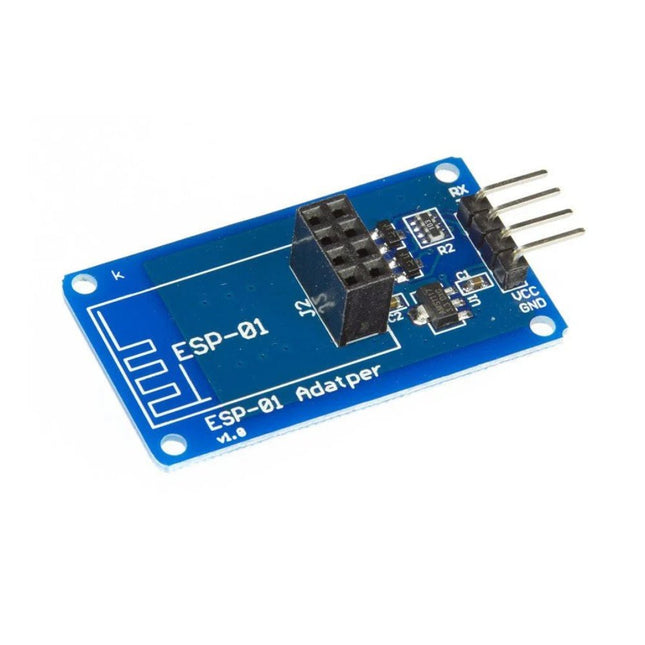
Kuongshun ESP-01 Adapter 3.3-5 V for Arduino
The ESP-01 Adapter 3.3-5 V is the ideal solution for connecting an ESP-01 ESP8266 module to a 5 V system such as Arduino Uno. Features Adapter module for ESP-01 Wi-Fi module 3.3 V voltage regulator circuit & onboard level conversion for easy use of 5 V microcontroller with ESP-01 Wi-Fi module Compatible with Uno R3 4.5~5.5 V (on-board 3.3 V LDO Regulator) Interface logic voltage: 3.3-5 V compatible (on-board level shift) Current: 0-240 mA
€ 5,95
Members € 5,36
-

LILYGO LILYGO T-Journal ESP32 Camera Module Development Board (Fish-eye Lens)
The T-Journal is a cheap ESP32 Camera Development Board that features an OV2640 camera, an antenna, a 0.91 inch OLED display, some exposed GPIOs, and a micro-USB interface. It makes it easy and quick to upload code to the board. Specifications Chipset Expressif-ESP32-PCIO-D4 240 MHz Xtensa single-/dual-core 32-bit LX6 microprocessor FLASH QSPI flash/SRAM, up to 4x 16 MB SRAM 520 kB SRAM KEY reset, IO32 Display 0.91' SSD1306 Power indicator lamp red USB to TTL CP2104 Camera OV2640, 2 Megapixel Steering engine analog servo On-board clock 40 MHz crystal oscillator Working voltage 2.3-3.6 V Working current about 160 mA Working temperature range -40℃ ~ +85℃ Size 64.57 x 23.98 mm Power Supply USB 5 V/1 A Charging current 1 A Battery 3.7 V lithium battery WiFi Standard FCC/CE/TELEC/KCC/SRRC/NCC (ESP32-chip) Protocol 802.11 b/g/n/e/i (802.11n, speed up to 150 Mbps) A-MPDU and A-MSDU polymerization, support 0.4 μS Protection interval Frequency range 2.4 GHz~2.5 GHz (2400 M ~ 2483.5 M) Transmit Power 22 dBm Communication distance 300m Bluetooth Protocol meet bluetooth v4.2BR/EDR and BLE standard Radio frequency with -98 dBm sensitivity NZIF receiver Class-1, Class-2 & Class-3 emitter AFH Audio frequency CVSD & SBC audio frequency Software Wifi Mode Station/SoftAP/SoftAP+Station/P2P Security mechanism WPA/WPA2/WPA2-Enterprise/WPS Encryption Type AES/RSA/ECC/SHA Firmware upgrade UART download/OTA (Through network/host to download and write firmware) Software Development Support cloud server development /SDK for user firmware development Networking protocol IPv4, IPv6, SSL, TCP/UDP/HTTP/FTP/MQTT User Configuration AT + Instruction set, cloud server, Android/iOS app OS FreeRTOS Included 1x ESP32 Camera Module (Fish-eye Lens) 1x Wi-Fi Antenna 1x Power Line Downloads Camera library for Arduino
€ 32,95€ 19,95
Members identical
-
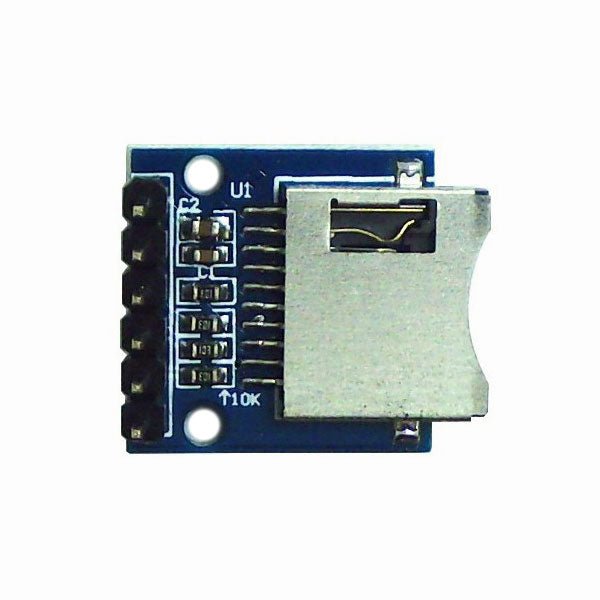
Kuongshun miniSD Card Module
miniSD Card Module
€ 3,95
Members € 3,56
-
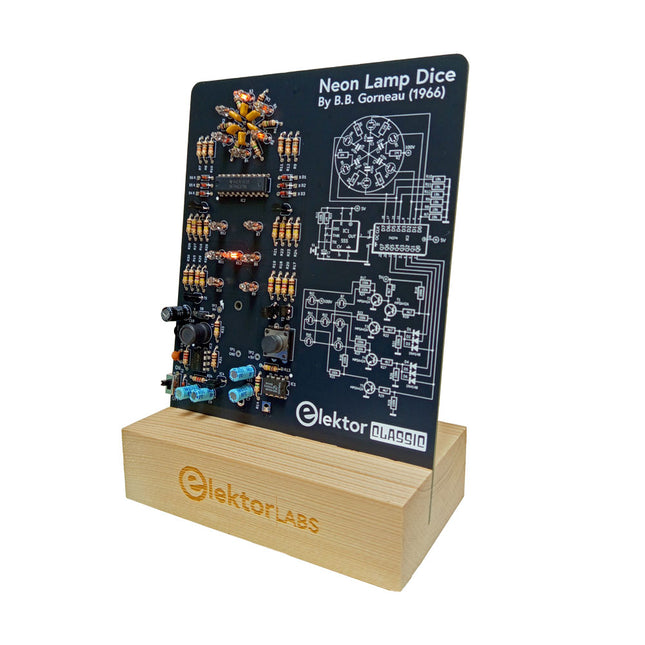
Elektor Labs Elektor Neon Lamp Dice
A Retro Roll with a Neon Soul LED-based dice are common, but their light is cold. Not so for this electronic neon dice, which displays its value with the warm glow of neon lamps. It is perfect for playing games on cold, dark winter evenings. The pips of the dice are neon lamps and the random number generator has six neon lamps to show that it is working. Even though the dice has an on-board 100-V power supply, it is completely safe. As with all Elektor Classic products, the dice too has its circuit diagram printed on the front while an explanation of how the circuit works can be found on the rear side. The Neon Lamp Dice comes as a kit of easy-to-solder through-hole parts. The power supply is a 9-V battery (not included). Features Warm Vintage Glow Elektor Heritage Circuit Symbols Tried & Tested by Elektor Labs Educational & Geeky Project Through-Hole Parts Only Included Printed Circuit Board All Components Wooden Stand Required 9 V battery Component List Resistors (THT, 150 V, 0.25 W) R1, R2, R3, R4, R5, R6, R14 = 1 MΩ R7, R8, R9, R10, R11, R12 = 18 kΩ R13, R15, R16, R17, R18, R21, R23, R24, R25, R26, R28, R30, R33 = 100 kΩ R32, R34 = 1.2 kΩ R19, R20, R22, R27, R29 = 4.7 kΩ R31 = 1 Ω Capacitors C1, C2, C3, C4, C5, C6 = 470 nF, 50 V, 5 mm pitch C7, C9, C11, C12 = 1 µF, 16 V, 2 mm pitch C8 = 470 pF, 50 V, 5 mm pitch C10 = 1 µF, 250 V, 2.5 mm pitch Inductors L1 = 470 µH Semiconductors D1, D2, D3, D4, D5, D6, D7 = 1N4148 D8 = STPS1150 IC1 = NE555 IC2 = 74HC374 IC3 = MC34063 IC4 = 78L05 T1, T2, T3, T4, T5 = MPSA42 T6 = STQ2LN60K3-AP Miscellaneous K1 = PP3 9 V battery holder NE1, NE2, NE3, NE4, NE5, NE6, NE7, NE8, NE9, NE10, NE11, NE12, NE13 = neon light S2 = Miniature slide switch S1 = Pushbutton (12 x 12 mm)
€ 39,95€ 29,95
Members identical
-
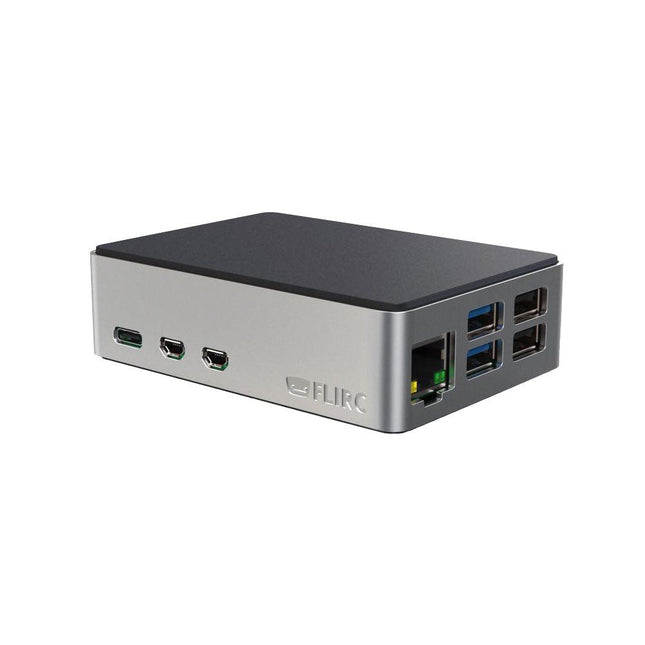
FLIRC FLIRC Case for Raspberry Pi 5
Discover the perfect case for your Raspberry Pi 5. FLIRC has made the power button accessible and improved it with LED support. Enjoy the familiar aluminium core heatsink you've come to love, nestled between two matte black soft-touch panels. Customised to fit into your entertainment system. Built-in Heat Sink This is the first affordable Raspberry Pi case made from aluminium. FLIRC wanted to ensure that form didn't take precedence over function, so they used the aluminium body of the case as a built-in heat sink. Included with the case is a thermal pad and 4 screws for easy assembly. Stability and Access FLIRC has built in rubber feet to elevate the case so that it simply floats under your TV. In addition to the built-in heatsink, small ventilation slots on the bottom ensure that the Raspberry Pi stays cool. The GPIO pins are accessible via the slot at the bottom of the case, and the SD card does not need to be disassembled to reach them. Power Button and LED Support The power button of the Raspberry Pi 5 is natively supported by the FLIRC housing. The activity LEDs are also clearly visible.
€ 21,95
Members € 19,76
-
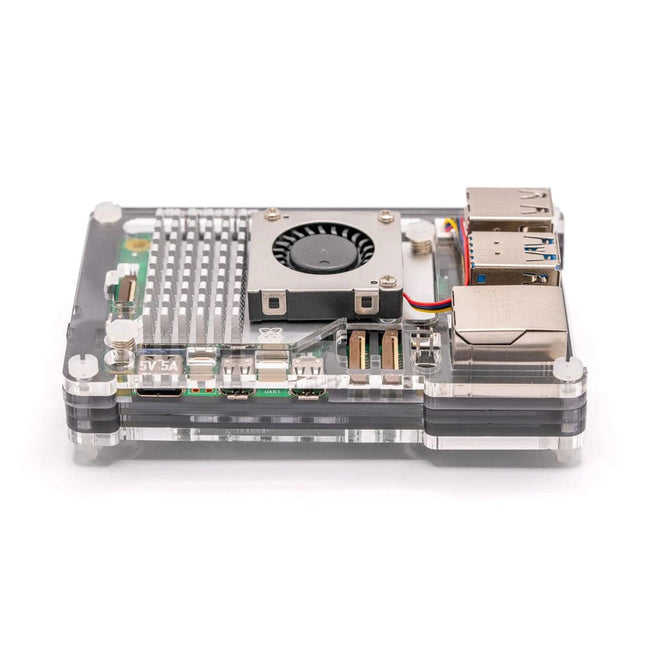
Pimoroni Pimoroni Pibow Coupe 5 (Ninja) – Case for Raspberry Pi 5
The slim, hackable and attractive case for Raspberry Pi 5. Pibow 5 lets you access all the ports and connectors on your Raspberry Pi and even has a clever little tab that will let you push the Pi 5's brand new power button whilst it's safely ensconced in its case. The case is designed to fit neatly around Raspberry Pi's Active Cooler. Features Compatible with Raspberry Pi 5 Official Active Cooler Super-slimline profile Fully HAT/pHAT compatible Protects your Raspberry Pi 5 Clear top leaves Raspberry Pi 5 visible (so you can gaze upon its wonder). GPIO cut-out Leaves all ports and connectors accessible External Power Button Nubbin via compliant mechanism magic Mounting holes on the base that will accommodate M2.5 screws/bolts and the studs on popular Danish ABS construction blocks Made from lightweight high-quality cast acrylic Great for hacking and tinkering Crafted out of five unique layers including a transparent top that leaves your Raspberry Pi visible inside. Each layer is laser-cut from colourful high-quality cast acrylic and once stacked they securely contain a Raspberry Pi 5 while leaving the primary ports and GPIO accessible. This case is lightweight and ideal for mounting to any surface. No tools are required for assembly or disassembly!
€ 11,95
Members € 10,76
-

Elektor Digital Programming with STM32 Nucleo Boards (E-book)
STM32 Nucleo family of processors are manufactured by STMicroelectronics. These are low-cost ARM microcontroller development boards. This book is about developing projects using the popular Nucleo development board. In the early chapters of the book, the architecture of the Nucleo family is briefly described. Software development tools that can be used with the Nucleo boards such as the Mbed, Keil MDK, TrueSTUDIO, and the System Workbench are described briefly in later Chapters. The book covers many projects using most features of the STM32 Nucleo development boards where the full software listings for Mbed and System Workbench are given for every project. The projects range from simple flashing LEDs to more complex projects using modules and devices such as GPIO, ADC, DAC, I²C, LCD, analog inputs and others. In addition, several projects are given using the Nucleo Expansion Boards, including popular expansion boards such as solid-state relay, MEMS and environmental sensors, DC motor driver, Wi-Fi, and stepper motor driver. These Expansion Boards plug on top of the Nucleo development boards and simplify the task of project development considerably. Features of this book Learn the architecture of the STM32 microcontrollers Learn how to use the Nucleo development board in projects using Mbed and System Workbench Toolchains Learn how to use the Nucleo Expansion Boards with the Nucleo development boards Update The Mbed compiler has been replaced with two software packages: The Mbed Studio and Keil Studio Cloud. Both of these software packages are free of charge and are available on the Internet. If you need assistance using the Keil Studio Cloud, please download the Guide below.
€ 34,95
Members € 27,96























